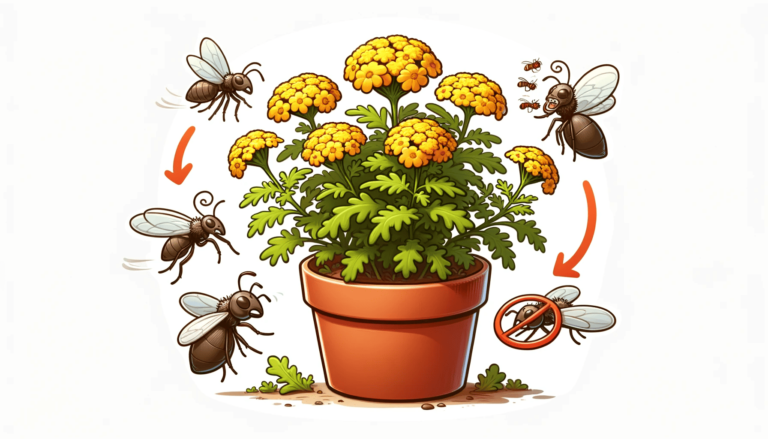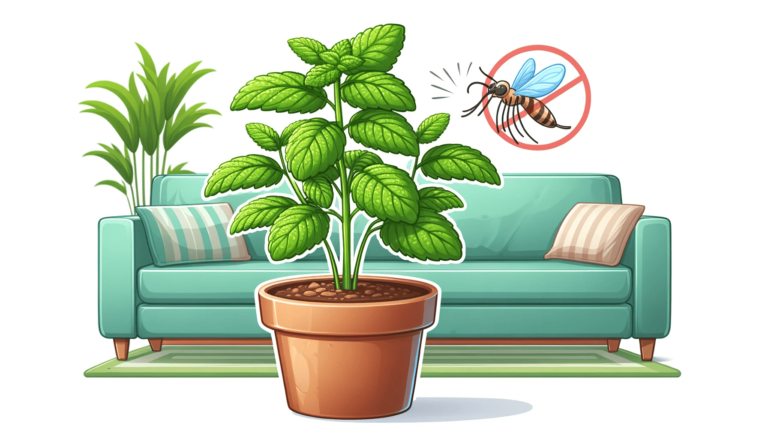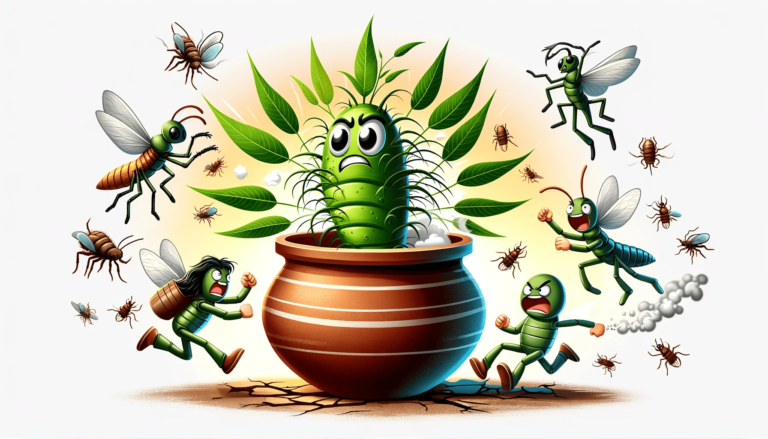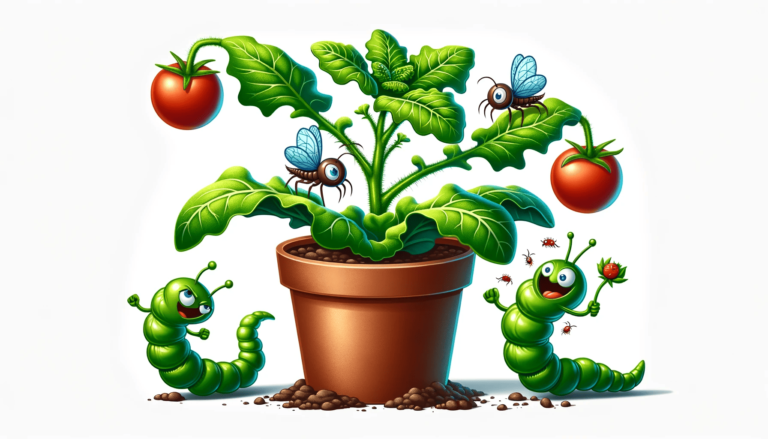27 Indoor Plants Great for Pest Control You Must Use
Are you tired of pesky bugs invading your indoor garden? You’re not alone!
Many plant enthusiasts face the challenge of keeping their green spaces free from pests. The good news?
Nature offers its own pest control solutions. In this article, we dive into 27 indoor plants that double as natural pest repellents.
Say goodbye to chemicals and hello to a greener, cleaner home.
1. Basil:
Not just for your pasta sauce! Basil repels flies and mosquitoes, making it a perfect kitchen companion.

Embracing basil as a natural insect repellent is a small yet significant step towards a healthier, more sustainable lifestyle.
It’s more than just a culinary delight; it’s a testament to the power of nature in providing solutions right under our noses.
So next time you water your basil plant, remember, it’s not just for your next meal; it’s guarding your home too!
2. Lavender:
Known for its soothing aroma, lavender also deters moths, fleas, and flies. Place it near windows or in your bedroom for a peaceful, bug-free environment.

Lavender, with its pleasant scent and pest-repelling properties, is an excellent addition to any home seeking natural solutions for insect control.
It’s a beautiful reminder of how nature can provide elegant solutions to everyday problems.
So next time you enjoy the calming aroma of lavender, remember, it’s also working hard to keep your home pest-free.
3. Mint:
This aromatic herb keeps ants and flies at bay. But be careful, it can be invasive; consider keeping it in pots.

Embracing mint as a natural insect repellent is a step towards a healthier, more eco-friendly home.
It’s an easy, aromatic, and effective method to keep pests at bay, proving that sometimes the best solutions are right in our herb gardens.
Remember, the next time you enjoy a sprig of mint, it’s doing more than just flavoring your tea; it’s keeping your home a pest-free sanctuary.
4. Rosemary:
While being a culinary favorite, rosemary also wards off mosquitoes. It thrives in sunny windows.

Rosemary is more than a culinary ingredient; it’s an eco-friendly, pleasant-scented solution for pest control.
By incorporating rosemary into your home, you’re not just enhancing your recipes; you’re creating a more comfortable, pest-free living space.
Whether you’re a food lover, a plant enthusiast, or someone seeking natural pest solutions, rosemary is a versatile and valuable choice.
5. Lemon Balm:
A member of the mint family, lemon balm repels mosquitoes. It’s great in teas too!

Lemon balm, with its refreshing scent and insect-repelling abilities, offers a delightful way to enhance your home’s ambiance while keeping it free from pests.
It’s a testament to the effectiveness of natural solutions in everyday life.
So, as you enjoy the fresh aroma of lemon balm, remember, it’s doing more than just pleasing your senses; it’s actively safeguarding your home.
6. Chrysanthemums:
Beautiful and effective, Chrysanthemums repel roaches, ants, and ticks.

Chrysanthemums do more than captivate with their beauty; they offer a natural and effective solution for pest control.
Integrating these flowers into your indoor environment not only beautifies your space but also provides a safe, eco-friendly way to keep pests at bay.
Remember, every time you admire a chrysanthemum, you’re looking at a plant that excels in both decoration and protection.
7. Marigolds:
These bright flowers are not just pretty; Marigolds deter mosquitoes and aphids.

Incorporating marigolds into your garden not only adds beauty but also acts as a natural pest control solution.
French marigolds, African marigolds, pot marigolds, and Mexican marigolds are among the best varieties to consider for effective pest control.
By utilizing these marigolds strategically in your garden, you can reduce the need for chemical pesticides and promote a healthier environment for your plants.
8. Catnip:
Surprisingly, the Catnip plant is more effective than DEET in repelling mosquitoes.
“Is the oldest, most effective and most common active ingredient in commercial insect repellents.” Wikipedia

Catnip serves a dual purpose in your home. Not only does it keep your cats entertained, but it also acts as a powerful, eco-friendly weapon against insects.
Next time you see your cat enjoying its catnip, remember, that this humble herb is silently guarding your home against unwanted insect invaders.
9. Geraniums:
Known for their mosquito-repelling properties, geraniums also add a pop of color to your space.

Geraniums are more than just a pretty face in your garden or home.
They exemplify the power of natural solutions, providing both aesthetic pleasure and a practical approach to maintaining a pest-free environment.
Their presence in any indoor or outdoor garden is a testament to the harmony of beauty and functionality.
10. Peppermint:
Apart from its refreshing scent, peppermint keeps a variety of pests away.

Embracing peppermint as a natural insect repellent is a smart, health-conscious choice that also adds a refreshing touch to your home.
Its ability to deter pests, combined with its delightful scent, makes peppermint an essential element of any indoor garden.
11. Chives:
Chives are great for your salad and also deter carrot flies and aphids.

Chives offer a simple yet effective natural solution for keeping pests at bay.
Their ease of cultivation and ability to repel a variety of insects make them a valuable addition to any indoor garden.
So next time you snip some chives for your meal, remember they’re doing double duty: adding flavor to your food and protection to your plants.
12. Petunias:
Petunias are colorful blooms that repel aphids, tomato hornworms, and asparagus beetles.

Incorporating petunias into your garden is a smart move.
Not only do they add a burst of color, but they also play a vital role in natural pest control.
This dual purpose makes them an invaluable addition to any garden, big or small.
So, the next time you admire your petunias, remember they’re not just there for their looks; they’re hard at work keeping your garden healthy and pest-free.
13. Thyme:
Thyme is ideal for small spaces and effective against cabbage worms.

Thyme is a small herb with significant benefits in pest control. Its ease of cultivation and effectiveness make it a valuable addition to any indoor garden or pest management strategy.
So, think of thyme not just as a kitchen staple, but as a key component of your home’s natural defense against pests.
14. Oregano:
Oregano is a versatile herb that repels cabbage butterflies.

Oregano oil is more than just a kitchen staple; it’s a powerful, eco-friendly weapon against insects. With its proven effectiveness and multiple benefits, it’s time to look at our humble garden herbs in a new light.
Have you tried using oregano oil in your insect control efforts? Share your experiences and let’s explore this natural wonder together!
15. Parsley:
Not just a garnish! Parsley keeps carrot flies and rose beetles away.

Parsley is more than just a kitchen staple; it’s a practical and natural solution for pest control.
Its addition to your indoor garden not only adds flavor to your dishes but also contributes to a healthier, pest-free environment.
So next time you snip some parsley for your meal, remember its dual role in your kitchen and garden.
16. Tansy:
Tansy has a distinctive smell that repels ants, flies, and moths.

Tansy, with its unique properties and historical significance, is a valuable addition to any indoor or outdoor garden for pest control.
Its ability to naturally repel various insects makes it an effective and sustainable choice for maintaining a healthy, pest-free environment.
So, while tansy may be less common in modern gardens, its role as a natural insect repellent is more relevant than ever.
Embrace tansy in your garden and join the league of eco-conscious gardeners!
17. Dill:
A friend to any vegetable garden, dill repels aphids and spider mites.

In the harmonious realm of gardening, dill emerges not just as a culinary treasure but as a stalwart defender against pests.
This fragrant herb offers more than meets the eye, providing a natural and eco-friendly shield for your beloved plants.
Embracing dill in your garden is a step towards sustainable gardening, intertwining the joys of growing your own herbs with the peace of mind that comes from natural pest control.
Let dill work its magic, and enjoy a healthier, more vibrant garden.
18. Fennel:
Fennel is great for attracting ladybugs and repelling aphids.

Fennel is more than just a culinary herb. Its potential as a natural insect repellent and a key player in pest control is both exciting and promising.
Its presence in your home serves multiple purposes: adding flavor to dishes and contributing to a healthier, insect-free environment.
So, next time you use fennel in your cooking, remember its dual role in your kitchen and garden.
19. Sage:
Sage has a strong natural scent that repels cabbage moths.

Sage offers more than just flavor for your dishes; it’s a natural and effective solution for keeping your home pest-free.
By incorporating sage into your indoor garden, you’re choosing a healthy, natural method to protect your space from common pests.
So, as you enjoy the aroma and taste of sage, remember its additional role as a guardian of your home against insects.
20. Citronella:
Widely known as a mosquito repellent, Citronella may not be your best choice!

While citronella plants might not be the mosquito-fighting warriors they’re often made out to be, they are still a delightful addition to your home or garden.
Their lemony scent can freshen up any space, and caring for them is quite straightforward.
Just remember, for serious mosquito repellent needs, you might want to look beyond just these plants.
21. Nasturtiums:
Nasturtiums are vibrant flowers that are a natural shield against whiteflies and other bugs.

Nasturtiums are not just a pretty face; they’re a practical solution for natural pest control.
By incorporating these colorful flowers into your indoor and outdoor gardens, you’re opting for an eco-friendly and effective method to keep your home and garden pest-free.
Enjoy their beauty and rest easy knowing they’re also guarding your space from unwanted guests. Happy
22. Garlic:
Garlic is not just for cooking; garlic also repels various pests.

Garlic’s strong scent and pest-repelling properties make it an ideal choice for natural pest control.
By incorporating garlic into your indoor garden, you’re not just enriching your culinary experience; you’re also creating a more comfortable and pest-free living space.
So, next time you cook with garlic, remember its additional role as a guardian of your home against pests.
23. Neem:
A powerhouse in pest control, neem can help keep your indoor plants healthy.

Neem’s natural insecticidal properties make it an invaluable ally in the fight against indoor pests.
By incorporating neem into your indoor plant collection, you’re opting for an effective, natural method to keep your living space healthy and pest-free.
Embrace the power of neem and enjoy the peace of mind that comes with a naturally protected indoor garden.
24. Onions:
Onions add flavor to dishes and keep pests like ants and aphids at bay.

Onions offer so much more than their culinary delight. They’re a practical, natural solution for a pest-free environment, indoors and out.
Next time you handle an onion, think of its dual role — a chef’s ingredient and a gardener’s friend.
Isn’t it fascinating how everyday items like onions can be reimagined for such unique uses? Have you tried using onions in your pest control routine? Share your experiences and thoughts in the comments below!
25. Pennyroyal:
Pennyroyal is a natural flea and ant repellent but keep it away from pets.

Pennyroyal offers more than just a minty fragrance; it’s a practical and effective solution for natural pest control.
By incorporating this herb into your indoor garden, you’re choosing a healthy, eco-friendly method to protect your space from common pests.
So, as you enjoy the aroma of pennyroyal, remember its additional role as a natural guard against insects and rodents.
26. Borage:
Borage is known to deter tomato hornworms and cabbage worms.

Borage is more than just an herb; it’s a natural, effective solution to pest control challenges.
Easy to grow and packed with benefits, borage is an excellent choice for gardeners and plant enthusiasts looking to manage pests naturally.
So, the next time you spot those beautiful blue blooms, remember the power they hold in keeping your garden healthy and pest-free.
With borage, you’re not just planting an herb; you’re investing in the success and sustainability of your garden.
27. Scented Geraniums:
Scented geraniums is another mosquito-repelling plant with the bonus of a pleasant aroma.

While scented geraniums offer a natural barrier against mosquitoes, they aren’t immune to other garden pests.
But with these tips, you can keep your plants healthy and thriving, ensuring your garden remains a fragrant haven.
Remember, regular care and attention are the keys to keeping any plant pest-free. Happy gardening! 🌿🌸
Embrace the Power of Nature in Pest Control
Integrating these plants into your indoor garden isn’t just about aesthetics or hobby gardening. It’s a strategic move towards sustainable, chemical-free pest management. These plants offer a dual purpose – enhancing your home’s beauty while keeping it free from unwanted guests.
Remember, diversity is key. By incorporating a variety of these plants, you create a more robust defense against a range of pests. Plus, you get the joy of an indoor garden that’s as beneficial as it is beautiful.
Unveiling the Secrets of Indoor Plant Pest Control
Tackling Pests with DIY Solutions: You love your indoor plants, but not the pests that come uninvited. Before reaching for chemical sprays, why not try some DIY pesticide recipes? Simple ingredients like dishwashing liquid, cinnamon, or vegetable oil can be powerful allies. Let’s explore how a pinch of cinnamon or a splash of soapy water can keep your green friends happy and pest-free.
Diatomaceous Earth: A Natural Wonder: Heard of diatomaceous earth? This natural, powdery substance works wonders in pest control. It’s safe, effective, and easy to use. Learn how to apply it to your plants without harm, ensuring those pesky intruders stay away.
Spice Up Your Pest Control: Combine the fiery strength of chili with the robustness of garlic for a potent pest repellent spray. This section will guide you through crafting this spicy concoction, detailing each step to ensure your plants get the best protection.
Plant-Based Pesticide Power: Nature has its own pest control solutions. Did you know leaves from plants like khakibos or tomatoes can be used as effective pesticides? Discover how to harness the power of these plant-based solutions in your indoor garden.
Essential Oils and Hydrogen Peroxide: These aren’t just for aromatherapy or first aid. When used correctly, essential oils and hydrogen peroxide can be formidable weapons against indoor plant pests. Delve into the specifics of how to use these substances safely and effectively.
Fostering Plant Health to Deter Pests: Healthy plants are less likely to succumb to pests. This part of the article focuses on cultivating the best growing conditions, proper watering, nutritional needs, and plant cleanliness. A healthy plant is a pest-resistant plant!
Early Detection: The Key to Pest-Free Plants: Catching pests early can save a lot of trouble. Learn the signs of infestations and get ahead of the problem. We’ll discuss practical, effective ways to inspect and manage any unwelcome visitors.
Managing Pests: Beyond the Basics: Sometimes, you need to take direct action. From washing to pruning, and employing natural insecticides like neem oil or pyrethrins, this section covers a spectrum of strategies to manage pests effectively and sustainably.
Meet Your Foe: Common Indoor Plant Pests: Knowledge is power. By understanding the appearance, damage, detection, and management of common pests like mealybugs or spider mites, you can better protect your indoor garden. Each pest is unique, and so is the way to handle them.
Household Insect Control: Safe and Sustainable: Finally, let’s discuss how to manage household insects in a way that’s safe for your plants and your living space. Balancing effectiveness and safety is key to sustainable pest control.
Conclusion
Armed with these insights and strategies, you’re now ready to defend your beloved indoor plants against pesky invaders. Remember, the best defense is a combination of prevention, early detection, and the right treatment. Happy gardening!
This guide aims to provide you with a comprehensive understanding of indoor plant pest control, equipping you with the knowledge and tools to keep your indoor garden thriving and pest-free.




